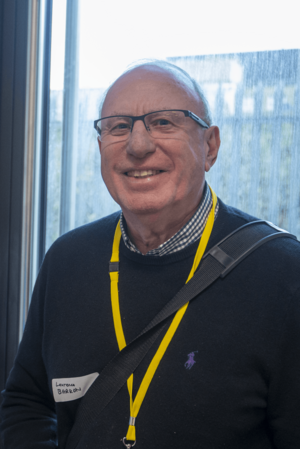Laurence D. Barron facts for kids
Quick facts for kids
Laurence D. Barron
|
|
|---|---|

Laurence D. Barron (2019)
|
|
| Born | 12 February 1944 |
| Nationality | British |
| Citizenship | British |
| Alma mater | University of Oxford |
| Known for | Raman optical activity |
| Awards | Chirality Medal (2011) |
| Scientific career | |
| Fields | Physical chemistry |
| Institutions | University of Glasgow |
| Thesis | The Theory of Optical Birefringence (1969) |
| Doctoral advisor | Peter Atkins |
| Other academic advisors | A. David Buckingham |
Laurence David Barron (born 12 February 1944 in Southampton, England) is a famous chemist. He used to be a professor of chemistry at the University of Glasgow. He is known for his important work on molecules that have a "handed" shape.
Think of your hands: they are mirror images of each other, but you can't make them fit exactly on top of each other. Molecules can be like this too! These are called chiral molecules. They are super important in life, like in amino acids, sugars, and many medicines.
Laurence Barron helped create a special method called Raman optical activity. This method uses light to figure out the exact 3D shape of these "handed" molecules. His work has made this method a powerful tool used by scientists all over the world.
Education and Early Career
Laurence Barron went to King Edward VI School, Southampton. He then studied chemistry at the Northern Polytechnic, where he got a top degree from London University in 1965.
He continued his studies at Lincoln College, Oxford. There, he earned his D.Phil. degree in 1969. His research was about how light interacts with molecules, especially how it scatters and changes.
After Oxford, Barron did more research at Cambridge University from 1969 to 1975. He then joined the Chemistry Department at the University of Glasgow in 1975. He became a full professor there in 1984.
Discovering Raman Optical Activity
Laurence Barron is most famous for his groundbreaking work on Raman optical activity. This idea first came to him during his D.Phil. studies. He realized that when light hits a "handed" molecule, it scatters in a very specific way. This scattering can show if the molecule is "left-handed" or "right-handed."
He published his first ideas about this with Peter Atkins in 1969. The full theory was published with David Buckingham in 1971. The first time scientists actually saw this effect was in 1973. This was a huge step forward in understanding the shapes of molecules.
Barron also expanded the idea of "handedness" to include moving particles and processes that change over time. This helped scientists understand why some reactions might produce more of one "handed" molecule than the other. This was a big mystery that many scientists, like Louis Pasteur, had tried to solve for a long time.
Awards and Recognition
Laurence Barron has received many awards for his important scientific discoveries.
- 2012, Zhang Dayu Memorial Lecture, China
- 2012, Joshua Schechter Memorial Lecture, Israel
- 2011, Chirality Medal
- 2008, Tetelman Visiting Fellow, Yale University, USA
- 2005, Elected Fellow of the Royal Society of Chemistry
- 2005, Elected Fellow of the Institute of Physics
- 2005, Elected Fellow of the Royal Society
- 2003, Visiting Professor, Universite Paul Sabatier, France
- 1998, Chemical Society of Zürich Lecture
- 1997, Guest Review Lecture, Association of Physicians of Great Britain and Ireland
- 1995, EPSRC Senior Fellow (1995–2000)
- 1995, Visiting Miller Research Professor, University of California, Berkeley, USA
- 1993, Sir Harold Thompson Award for Molecular Spectroscopy
- 1992, Elected Fellow of the Royal Society of Edinburgh
- 1987, F.L. Conover Memorial Lecture, USA
- 1984, G.M.J. Schmidt Memorial Lecture, Israel
- 1977, Corday–Morgan Medal and Prize

